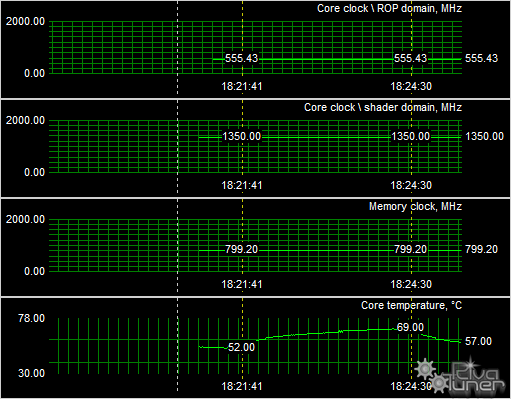3 - Power Consumption, Heat and Volume levels
Power consumption
We'll now show you some tests we have done on overall power consumption of the PC. Looking at it from a performance versus wattage point of view, the power consumption is not as bad as I expected it to be.
Our test system contains a Core 2 Duo X6800 Extreme Processor, the nForce 680i mainboard, a passive water-cooling solution on the CPU, DVD-rom and a WD Raptor drive. The results:
- PC in Idle = 167 Watt
- PC 100% usage (wattage gaming Peak) = 228 Watt
The methodology is simple: We have a device constantly monitoring the power draw from the PC. After we have run all our tests and benchmarks we look at the recorded maximum peak; and that's the bulls-eye you need to observe as the power peak is extremely important. Bare in mind that you are not looking at the power consumption of the graphics card, but the consumption of the entire PC.
The monitoring device is reporting a maximum system wattage peak at roughly 228 Watts with a GeForce 9600 GT card installed, and that is not excessive at all. So here's my power supply recommendation:
- A single GeForce 9600 GSO requires you to have a 450 Watt power supply (which we think is the bare minimum for any modern PC regardless of VGA). That power supply needs to have (in total) at least 26 Amps available on the 12 volts rails.
- A second GeForce 9600 GSO installed on this system requires you to have a 550 Watt power supply unit at minimum if you use it in a high-end system. That power supply needs to have (in total) at least 36 Amps available on the 12 volts rails.
There are many good PSU's out there, please do have a look at our many PSU reviews as we have loads of recommended PSU's for you to check out in there. What would happen if your PSU can't cope with the load?:
- bad 3D performance
- crashing games
- spontaneous reset or imminent shutdown of the PC
- freezes during gameplay
- PSU overload can cause it to break down
Noise Levels coming from the graphics card
When graphics cards produce a lot of heat, usually that heat needs to be transported away from the hot core as fast as possible. Often you'll see massive active fan solutions that can indeed get rid of the heat, yet all the fans these days make the PC a noisy son of a gun. I'm doing a little try out today with noise monitoring, so basically the test we do is extremely subjective. We bought a certified dBA meter and will start measuring how many dBA originate from the PC. Why is this subjective you ask? Well, there is always noise in the background, from the streets, from the HD, PSU fan etc etc, so this is by a mile or two not a precise measurement. You could only achieve objective measurement in a sound test chamber.
The human hearing system has different sensitivities at different frequencies. This means that the perception of noise is not at all equal at every frequency. Noise with significant measured levels (in dB) at high or low frequencies will not be as annoying as it would be when its energy is concentrated in the middle frequencies. In other words, the measured noise levels in dB will not reflect the actual human perception of the loudness of the noise. That's why we measure the dBA level. A specific circuit is added to the sound level meter to correct its reading in regard to this concept. This reading is the noise level in dBA. The letter A is added to indicate the correction that was made in the measurement. Frequencies below 1kHz and above 6kHz are attenuated, where as frequencies between 1kHz and 6kHz are amplified by the A weighting.
|
|||||||||||||||||||||||||||||||||||||||
We test all cards on dBA levels. Obviously the reference coolers all perform roughly the same. The customized coolers are either louder or softer depending on what they try to achieve. Here are the results:
|
Graphics card |
IDLE |
During Gaming |
|
9600 GT 512MB NVIDIA |
38 |
42 |
|
9600 GSO 512MB Point of View |
43 |
44 |
You'll notice that the card isn't the most silent one due to the cooler design. Looking at it from another side, it's not annoying either. You'll hear it slighly. Let's have a look at the temperatures.
Point of View GeForce 9600 GSO core temperature
Let's have a look at the temperatures of the GPU under load with the cooler used on this product.
 |
||
The card return roughly the following results back:
- GPU Idle - 52 Degrees C
- GPU under full load 70 Degrees C
This product has exactly same cooler as the reference design, though a faster clock should make the temps rise a little. We measure at a set 21 Degrees C room-temperature. All in all, fine results though idle temperatures are a little bit higher then usual.
